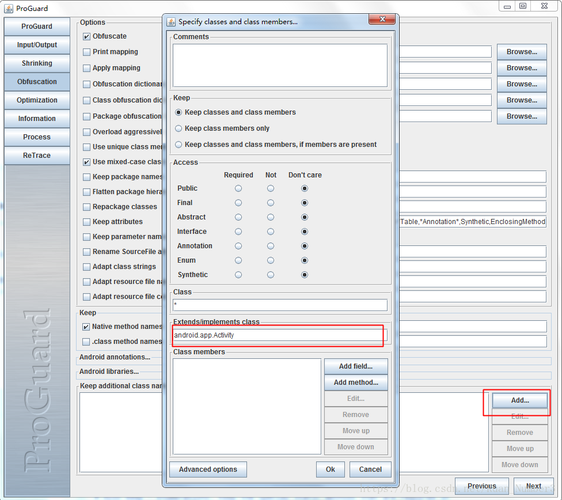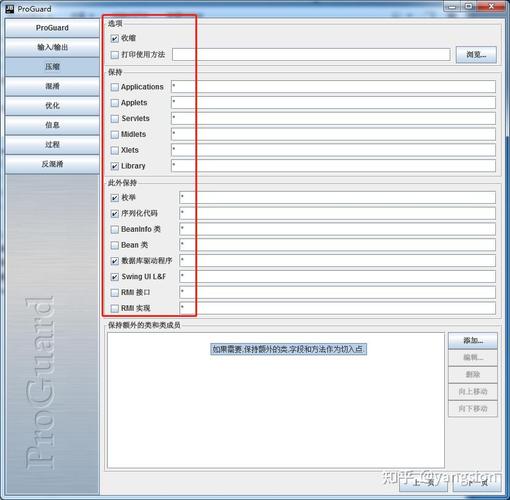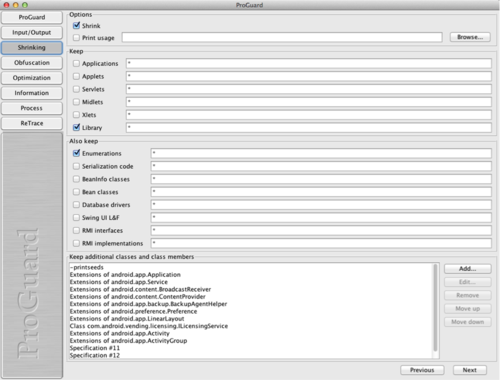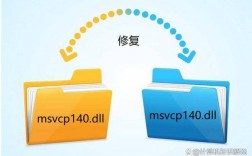ProGuard 报错分析与解决方案
ProGuard 是一个 Java 类文件压缩、优化和混淆工具,它可以帮助开发者减少 APK/JAR 文件的大小,提高应用性能,以及增加反编译难度,在使用 ProGuard 时,经常会遇到各种错误和警告信息,本文将详细分析常见的 ProGuard 报错类型,并提供相应的解决方案。
1. 未找到引用的类或方法

错误示例:
- Warning: com.example.MyClass: can't find referenced class com.example.OtherClass
- Warning: com.example.MyClass: can't find referenced method 'void <init>()' in program class com.example.OtherClass
原因分析:
代码中使用了未被包含在项目中的类或方法。
ProGuard 配置中没有正确指定需要保留的类或方法。
解决方案:
确保所有使用的库都已添加到项目的依赖中。

在proguardrules.pro 文件中添加规则,保留必要的类和方法。
- keep class com.example.OtherClass { *; }
- keepclassmembers class com.example.OtherClass { *; }
2. 反射调用失败
错误示例:
- Warning: there were 10 unresolved references to classes or interfaces.
- You may need to specify additional library jars (using 'libraryjars').
原因分析:
使用了反射机制调用类或方法,但 ProGuard 无法识别这些调用。
ProGuard 默认会移除未使用的代码,导致反射调用失败。

解决方案:
在proguardrules.pro 文件中添加规则,保留使用反射的类和方法。
- keep class com.example.ReflectionClass { *; }
- keepclassmembers class com.example.ReflectionClass { *; }
- keepclasseswithmembernames class * {
- native <methods>;
- }
3. 序列化问题
错误示例:
- Warning: com.example.SerializableClass: can't find referenced class java.io.Serializable
原因分析:
类实现了Serializable 接口,但 ProGuard 无法识别该接口。
ProGuard 可能会移除实现Serializable 接口的类的字段,导致序列化失败。
解决方案:
在proguardrules.pro 文件中添加规则,保留实现Serializable 接口的类及其字段。
- keepclassmembers class * implements java.io.Serializable {
- private *;
- }
4. 资源文件丢失
错误示例:
- Error: Can't read [com/example/res/drawable/icon.png] (Can't process class [com/example/BuildConfig.class] (Unexpected end of ZLIB input stream))
原因分析:
ProGuard 在处理资源文件时出现问题,可能是由于资源文件损坏或路径错误。
ProGuard 配置中没有正确指定资源文件的处理方式。
解决方案:
确保所有资源文件都存在且路径正确。
如果不需要处理资源文件,可以在proguardrules.pro 文件中添加规则跳过资源文件。
- dontwarn com.example.R
5. 第三方库不兼容
错误示例:
- Error: org.apache.commons.lang3.StringUtils cannot be resolved
原因分析:
使用的第三方库与 ProGuard 不兼容,或者库中的部分代码被错误地移除。
ProGuard 无法正确识别第三方库中的类和方法。
解决方案:
更新第三方库到最新版本,确保其与 ProGuard 兼容。
在proguardrules.pro 文件中添加规则,保留第三方库的类和方法。
- keep class org.apache.commons.lang3.** { *; }
- keepclassmembers class org.apache.commons.lang3.** { *; }
| 错误类型 | 错误示例 | 原因分析 | 解决方案 |
| 未找到引用的类或方法 | Warning: com.example.MyClass: can't find referenced class com.example.OtherClass | 代码中使用了未被包含的类或方法;ProGuard 配置中没有正确指定需要保留的类或方法 | 确保所有使用的库都已添加到项目的依赖中;在proguardrules.pro 文件中添加规则,保留必要的类和方法 |
| 反射调用失败 | Warning: there were 10 unresolved references to classes or interfaces. | 使用了反射机制调用类或方法,但 ProGuard 无法识别这些调用;ProGuard 默认会移除未使用的代码,导致反射调用失败 | 在proguardrules.pro 文件中添加规则,保留使用反射的类和方法 |
| 序列化问题 | Warning: com.example.SerializableClass: can't find referenced class java.io.Serializable | 类实现了Serializable 接口,但 ProGuard 无法识别该接口;ProGuard 可能会移除实现Serializable 接口的类的字段,导致序列化失败 | 在proguardrules.pro 文件中添加规则,保留实现Serializable 接口的类及其字段 |
| 资源文件丢失 | Error: Can't read [com/example/res/drawable/icon.png] | ProGuard 在处理资源文件时出现问题,可能是由于资源文件损坏或路径错误;ProGuard 配置中没有正确指定资源文件的处理方式 | 确保所有资源文件都存在且路径正确;如果不需要处理资源文件,可以在proguardrules.pro 文件中添加规则跳过资源文件 |
| 第三方库不兼容 | Error: org.apache.commons.lang3.StringUtils cannot be resolved | 使用的第三方库与 ProGuard 不兼容,或者库中的部分代码被错误地移除;ProGuard 无法正确识别第三方库中的类和方法 | 更新第三方库到最新版本,确保其与 ProGuard 兼容;在proguardrules.pro 文件中添加规则,保留第三方库的类和方法 |
FAQs
Q1: ProGuard 报错时如何快速定位问题?
A1: 当 ProGuard 报错时,可以采取以下步骤快速定位问题:
1、查看日志文件:ProGuard 生成的日志文件通常会包含详细的错误信息和警告,通过阅读日志可以了解具体的错误类型和位置。
2、检查配置文件:确认proguardrules.pro 文件中的配置是否正确,是否有遗漏的规则。
3、逐步排除法:逐步注释掉proguardrules.pro 文件中的规则,重新运行 ProGuard,观察错误是否消失,从而确定是哪条规则导致了问题。
4、查阅文档和社区:参考 ProGuard 官方文档(https://www.guardsquare.com/en/products/proguard/manual/usage)和相关社区论坛,寻找类似问题的解决方法。
5、调试模式:启用 ProGuard 的调试模式,获取更详细的调试信息,可以在命令行中添加verbose 参数运行 ProGuard。
Q2: ProGuard 如何处理敏感信息的保护?
A2: ProGuard 提供了多种方式来保护敏感信息,防止其被反编译和逆向工程,以下是几种常见的方法:
1、代码混淆:通过重命名类、方法和字段名,使代码难以理解,可以在proguardrules.pro 文件中使用obfuscate 选项启用代码混淆。
- obfuscate
2、字符串加密:对敏感字符串进行加密存储,运行时再解密,可以使用自定义的加密算法或现有的库来实现。
- public class EncryptionUtils {
- private static final String SECRET_KEY = "mySecretKey";
- private static final String ALGORITHM = "AES";
- private static final byte[] keyValue = SECRET_KEY.getBytes();
- public static String encrypt(String data) throws Exception {
- Key key = generateKey();
- Cipher c = Cipher.getInstance(ALGORITHM);
- c.init(Cipher.ENCRYPT_MODE, key);
- byte[] encVal = c.doFinal(data.getBytes());
- return Base64.encodeToString(encVal, Base64.DEFAULT);
- }
- private static Key generateKey() throws Exception {
- return new SecretKeySpec(keyValue, ALGORITHM);
- }
- }
3、资源文件保护:对资源文件(如配置文件、数据库等)进行加密或签名验证,确保其完整性和安全性,使用 Android 的Resources 类加载加密后的资源文件。
4、动态加载:将敏感逻辑放在动态加载的库中,运行时才加载,减少静态分析的风险,可以使用 Android 的DexClassLoader 动态加载 DEX 文件。
5、使用安全库:利用成熟的安全库(如 Bouncy Castle)来处理加密、解密和签名等操作,确保实现的安全性和可靠性。
通过以上方法,可以有效地保护应用中的敏感信息,提高应用的安全性。











